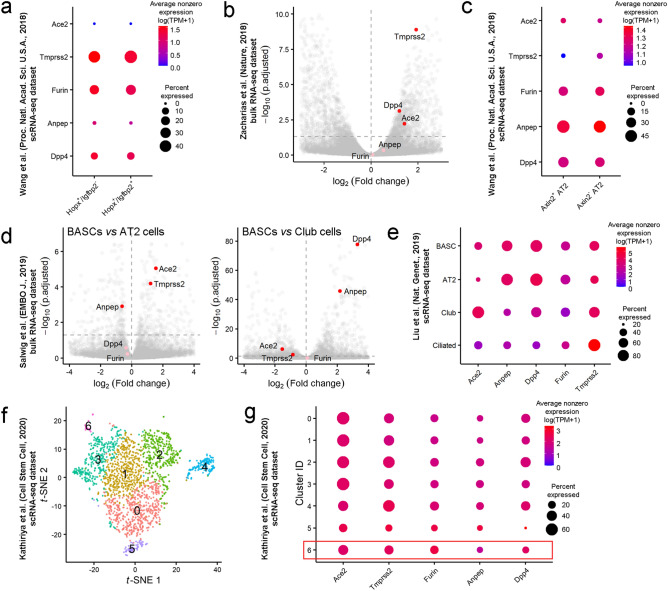Figure 2.
Lung epithelial stem cells express SARS-CoV-2 entry factors. (a) Expression of Ace2, Tmprss2, Furin, Anpep and Dpp4 in the subpopulation of AT1 cells that maintain the ability to transdifferentiate into AT2 cells (Hopx + /Igfbp2- cells) and in terminally differentiated AT1 cells (Hopx + /Igfbp2 + cells). The results for the scRNA-seq dataset from mice at postnatal day 6033 are presented. The dot size indicates the proportion of cells in the respective cell type with greater-than-zero expression of the respective SARS-CoV-2 entry factor, while the dot color indicates the average nonzero expression value. (b) Volcano plot showing elevated expression of Ace2, Tmprss2 and Dpp4 in AEPs compared to differentiated AT2 cells (bulk RNA-seq dataset11). Each dot represents one gene. The log2 (fold change) in the expression levels of Ace2, Tmprss2, Furin, Anpep and Dpp4 is indicated by the colored dots (red, differentially expressed genes (p.adjusted < 0.05); pink, non-differentially expressed genes). (c) Expression of SARS-CoV-2 entry factors in AEP AT2 cells expressing Axin2 in the dataset from Wang et al.33. (d) Volcano plots showing the expression levels of Ace2 and Tmprss2 in BASCs versus differentiated AT2 cells (left panel) or differentiated club cells (right panel). The log2 (fold change) in the expression levels of differentially expressed genes (p.adjusted < 0.05) is shown in red; of non-differentially expressed genes, in pink. (e) Expression of SARS-CoV-2 entry factors in BASCs, AT2 cells, secretory club cells and ciliated cells. The proportion of Ace2-expressing cells in the BASC population was higher than that in the alveolar AT2 cell population but lower than that in the bronchiolar club cell population. (f) t-SNE plot of 1952 scRNA-seq profiles from the scRNA-seq dataset40, colored by cluster assignment. Cluster 6 contains H2-K1high club-like stem cells (Supplementary Information Figs. 2c and 2d). (g) SARS-CoV-2 entry factors are expressed in a large proportion of H2-K1high club-like stem cells as well as in other clusters of club cells and AT2 cells.

